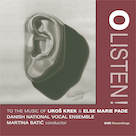

Danish National Vocal Ensemble: O Listen! To the Music of Uroš Krek& Else Marie Pade
OUR Recordings
While O Listen! is the Danish National Vocal Ensemble's ninth OUR Recordings album, it's the label debut for its August 2023-appointed Chief Conductor Martina Batic. That makes the release special, but as significant is the music she selected for the project by composers Uroš Krek (1922-2008) and Else Marie Pade (1924-2016). Pieces by the Slovenian Krek, one of the musical heroes of Batic's homeland, appear first, after which a number of choral works by the Danish composer Pade, including the world premiere recording of her incredible Maria (1980), follows. As often happens in Danish National Vocal Ensemble (DNVE) performances, the arrangements feature the full choir but soloists regularly step forward too. A full-time professional chamber choir, the DNVE commands a huge choral repertoire and has issued recordings featuring the music of, among others, Nielsen, Messiaen, Ligeti, and Kodály.
While Krek's first job was at Radio Slovenia (where he became the music programme's editor-in-chief), his decade-long tenure (1959-1968) at the Institute of Ethnomusicology of the Slovenian Academy of Sciences and Arts proved to be most pivotal as it was during that time that he collected and studied Slovenian folk music. That deep and prolonged immersion seeped into his own writing, which includes the celebrated Sonata for Violin and Piano (1946), the popular Sinfonietta (1951), the Sonatina for Strings (1956), and, of course, the choral works presented on this DNVE release. His Three Autumn Songs (1991) begins with the enrapturing counterpoint of “O Listen,” the harmonious beauty of the choir's voices on full display. Affecting in the directness of their emotional expression, the songs, all set in English, range in tone from defiant and rhapsodic to tender and supplicating. An emigrant setting focusing on two Slovenian lovers, the poignant Vöra bije (The Clock Ticks) (1997) is permeated with the grief and sadness a couple experiences after one partner leaves for America. Krek's material is marked by clarity and sensitivity of expression, such that pieces like Salmo XLII (1991) and Samotno ugibanje (1987, rev. 1998) connect instantly with the listener and register their meanings without ambiguity. Concluding his part of the album is 1994's gloriously declaiming Vester, Camenae (I am yours, Muses).
One of Denmark's most celebrated and pioneering composers, Pade is represented by works spanning almost three decades. Her part of the programme starts with Korsatser, originally written between 1951 and 1955 and rearranged for mixed choir by John Høybye in 2009; Völo-spa hoc est, composed for women's choir in 1956; and 1980's electroacoustic setting Maria. Pade's career began with the creation of a number of large-scale instrumental and orchestral works, but after joining Danmarks Radio as a producer and gaining access to its sound laboratory the music she composed during the late ‘50s and early ‘60s took an electronic turn. Suffering from the long-term effects of WWII, she retreated from the world thereafter, though she did eventually create two large-scale electroacoustic works, Maria (1980) and Immortella (1984), and has in recent years been re-discovered by a new generation of electronic musicians appreciative of the innovative work she did.
Comprising three songs based on a selection of Danish poems, Korsatser was originally created as a series for solo voice and piano in the ‘50s but was recast in 2008 as a work for mixed choir and electronics; it appears here, however, in a choral form only. The delicate, incantatory hush of “I drømme” (In dreams) provides a commanding introduction, and the lustrous songs that follow, the gently soaring “Den hvide nat” (The white night) and wholly enchanting “Midsommervise” (Midsummer's song), do nothing to weaken that spell. Performed by a four-part women's choir (SSAA), Völo-spa hoc est (This is the Prophecy of the Völva) (1956) is based on the Icelandic poem “Vølvens spådom” from the end of the ninth century and memorably merges Gregorian-styled chanting with contemporary harmonic writing.
It's Maria, scored for coloratura soprano, bass baritone, speaking choir, seven trombones, and electronics, that is undeniably the album's most striking piece, however. While the vocal part was completed in 1980, the electronic material was generated by Pade in 1972 from her own recordings of prepared-piano sounds and synthetically created church bell-like sonorities. Electronic treatments extend to the vocal parts too, such that the speaking choir in each section is first heard acoustically, then as a whisper, and finally with echo. In terms of text, Maria is a religious work whose eleven movements document the saga of the Virgin Mary, from the miracle of Jesus's birth and the anguish of Crucifixion to a longing for his return and her eventual sanctification. Given how critical they are to the performance, bass-baritone Jakob Soelberg and soprano Anna Miilmann, both permanent members of the DNVE, deserve mention as the soloists. After the clangorous bell tone sounds, the work opens with her singing against a backdrop of reverberating piano-sourced textures. Soelberg and the choir follow, and then Miilmann accompanied by a writhing swirl of electronic flourishes. A cyclical pattern quickly establishes itself that sees the ominous bell tone preceding Miilmann and then Soelberg, with an ever-mutating electronic component joining her and the unaccompanied bass-baritone followed by the choir.
As Maria advances, it becomes challenging to determine whether it's the vocal or electronic elements that are the more arresting. Regardless, the work, which exudes the character of an ancient ritual, and the DNVE's realization thereof is mesmerizing and something truly special. Of course the release has undeniable appeal for its presentation of various works by Krek and Pade, but it's Maria that is its most noteworthy piece. It's easy to visualize a concert hall filled with listeners held completely spellbound by the material.
May 2025